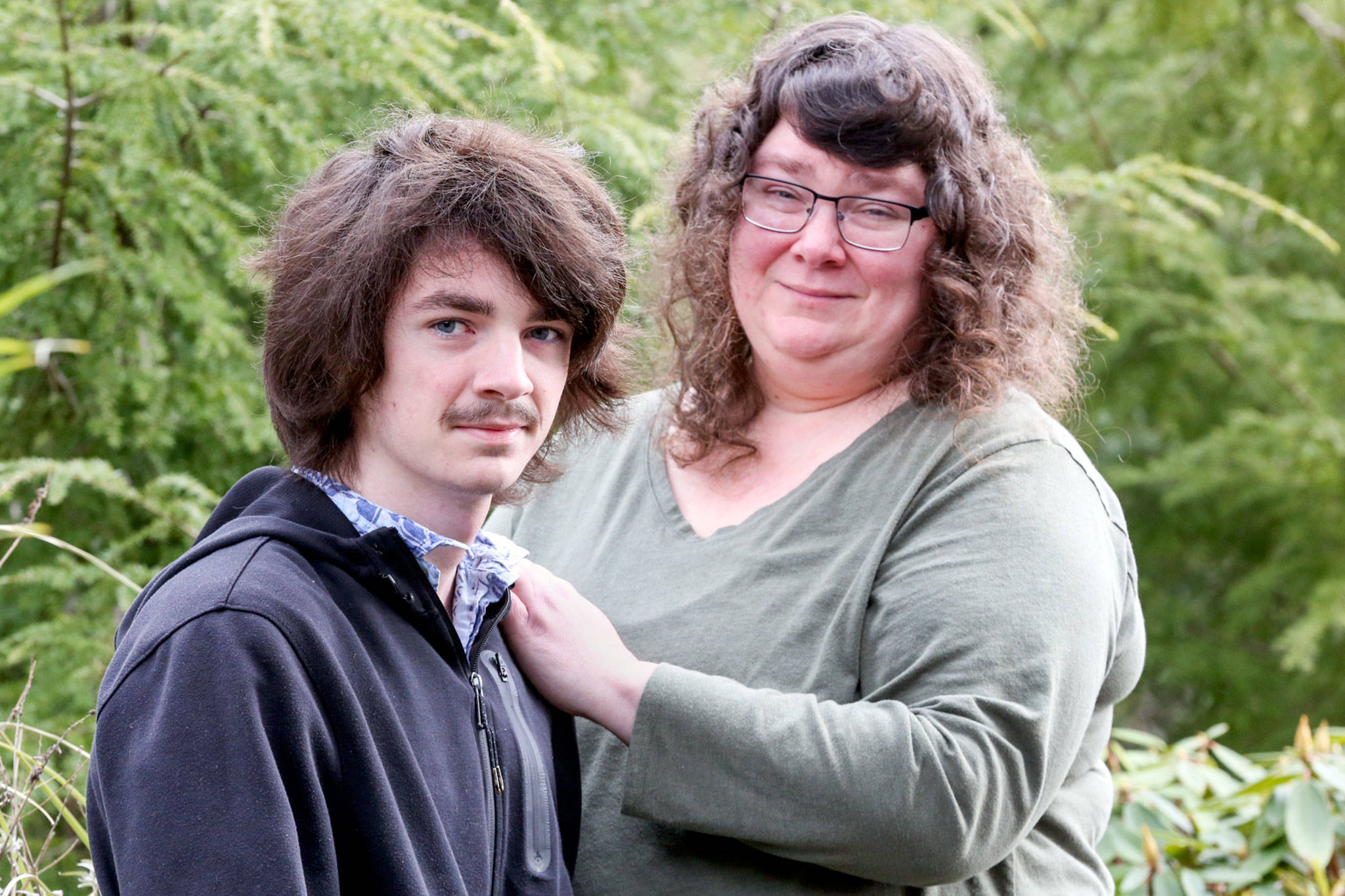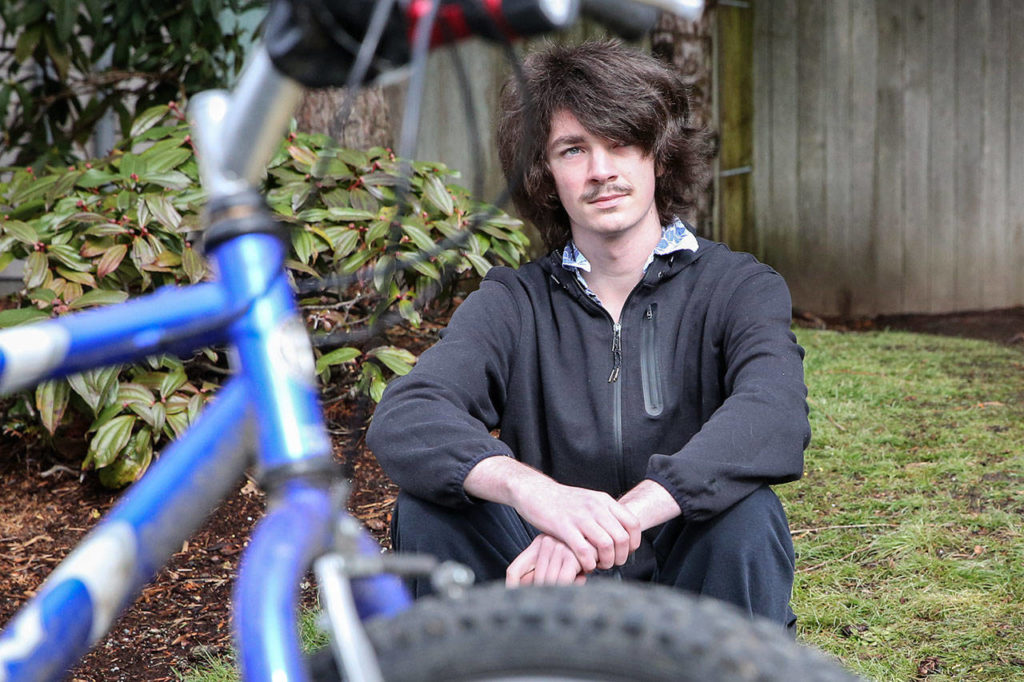“I’m going biking with my friends,” Joey Walker told his mom.
Instead, he rode alone to an I-5 overpass, parked his bike, climbed over the railing and jumped.
His second suicide attempt was on an evening his family made plans to go out to dinner. Joey told them he wanted to stay home. It gave him the time to be alone, walking upstairs to a bathroom, grabbing a handful of pills, and swallowing them.
The third time was in his room, spreading a tarp on the floor, then using a kitchen knife to slice cuts into both of his arms.
Looking back, he now sees the success hidden in his failures to take his life — all occurring while he was in middle school.
“My story is as raw as it gets,” he said in the introduction to the essay he wrote detailing his struggles with depression.
Entitled “Failure, Failure, Failure, Freedom,” it is included in a book written by Scriber Lake High School students of their life experiences. His story is an emotional beacon, offering assurance for others suffering from depression, anxiety or cutting.
“They see someone who has been there and pulled out of it,” said Joey’s mom, Mycca Walker. “It gives them encouragement to reach out their hand and ask for help. It’s something we need to talk about, and talk about, and talk about, until it doesn’t make people feel uncomfortable anymore.”
Peer-to-peer is one of the most effective ways to talk to teens about issues such as depression and thoughts of suicide, said Wendy Burchill, who works on injury prevention issues at the Snohomish Health District.
Some of the stigma that comes with suicidal thoughts is because peers can’t relate to someone in such pain, she said. Stories like Joey’s help reduce feelings of isolation.
“Young people in that space feel like they’re all alone,” she said. “It lifts that stigma.”
Troubled times
Joey’s troubles began in seventh grade. Students crowded the hallways at Meadowdale Middle School. Some went out of their way to deliberately bump him as he walked to class. His mom sometimes got calls from him in the midst of a panic attack.
It was early in the school year when Joey, then 14, overwhelmed with depression and anxiety and having trouble sleeping, rode his bike to the I-5 bridge, intent on jumping, despite a fear of heights.
He said he landed in grass and then blacked out from his fall. When he awoke, he scrambled up the hill, went home and told no one.
The second attempt occurred about six weeks later. The bottle of pills he grabbed in the upstairs bathroom was an over-the-counter pain reliever. But taken in big enough quantities, they can be life-threatening. He gulped down 15 of the pills and felt a sense of relief.
“I felt happy that it was all going to finally end,” he wrote in his essay. He went to bed and pulled up the covers. He awoke about four hours later.
His third and final attempt — using a knife to cut his arms — occurred at the beginning of eighth grade. Of the three, it is the hardest to read. Joey said it was also the hardest to write.
New beginning
Life was different for Joey at Scriber Lake High School. The alternative school is a place where many other students have faced serious emotional issues.
Yet Joey’s troubles largely were a secret unto himself. Even his parents only knew of one — the last — of their son’s suicide attempts.
That all changed one day in Joey’s freshman writing class. Another student came and read the story of his suicide attempts and living with schizophrenic episodes.
Joey decided it was time to write his own story and stayed after school twice a week to work on it.
As his teacher, Marjie Bowker, learned the details, she told Joey he had to tell his parents the whole story. He came home and told his mom that night.
“It was a grueling conversation,” his mom said. Joey worried about how much it would hurt his parents to hear it.
Both he and his mom realized that the raw honesty of his story could help other kids.
Joey, now a 16-year-old sophomore, recently read his essay to a school assembly. Bowker’s freshman writing class will read it this week. “It really means a lot to him every time he hears his story has affected somebody,” she said.
Joey calls his decision to enroll at Scriber one of the best decisions he’s ever made. He has fun with teachers and fellow students. He’s made friends. He said he’s the happiest he’s been in a long time.
He’s turned to exercise — lifting weights, going for a run, a bike ride or a workout with a punching bag — to help him cope.
His mom said she’s proud of her son for writing his essay. Her son’s experience has brought the family closer together. They’ve learned to act when one of them is having a tough day.
“Sometimes it’s just sitting with them and being in the same room,” she said. “Other times you need to talk it out. And sometimes you just need a hug.”
But what about that word “freedom,” the last word in the title of Joey’s essay? We find out in its last scene, a bike ride he took with friends. They sit at the top of one of Edmonds’ biggest hills. They pause to consider just how steep it is and whether they should take the chance of experiencing its roller coaster-like drop.
Joey starts down first. He descends, and it’s maybe even faster than he thought. But the thrill it provides fills him with youthful exuberance, over-the-top joy.
6 youth suicides reported this school year in Snohomish County
It was the shocking rise in teen suicides during the 2014-15 school year in Snohomish County that brought about action.
Thirteen youths — including two 12-year-olds — took their lives between September and June.
Now nearly all local schools provide information to middle and high school students on suicide prevention and the signs that could signal someone is considering suicide.
“That’s a huge improvement over what I saw in 2014 and 2015,” said Wendy Burchill, an injury prevention specialist at the Snohomish Health District.
Since then, the number of youth suicides has fluctuated each school year — three in the 2016-17 school year, and 11 in the 2017-18 school year.
So far this school year there have been six, all among boys. The youngest was a 13-year-old from Arlington. Others were a
17-year-old boy in Lake Stevens, a 15-yearold boy from Monroe and 14- and 17-yearolds from Marysville.
The most recent, occurring earlier this month, was an 18-year-old man in Edmonds who graduated in June.
This school year was unusual because there were three suicides in September — the beginning of the school year. “I hope it stops, but my concern is we tend to see the most suicides in the spring,” Burchill said.
“Consistently over the years, we see more in March and April. I’m afraid this could be one of our bad years, since we already have six.”
Sharon Salyer: 425-339-3486 or salyer@heraldnet.com.
Where to get help
Resources for teens experiencing depression, thoughts of suicide or other mental health issues include:
Volunteers of America’s 24-hour care crisis line at 800-584-3578 and online chat service at www.imhurting.org.
The Trevor Project, which serves lesbian, gay, bisexual and transitioning youth, operates a 24-hour crisis intervention and suicide prevention phone service at 866-488-7386. Access a text service with “START” to 678678, or an online chat from 3 a.m. to 10 p.m. daily.
Talk to us
> Give us your news tips.
> Send us a letter to the editor.
> More Herald contact information.


























